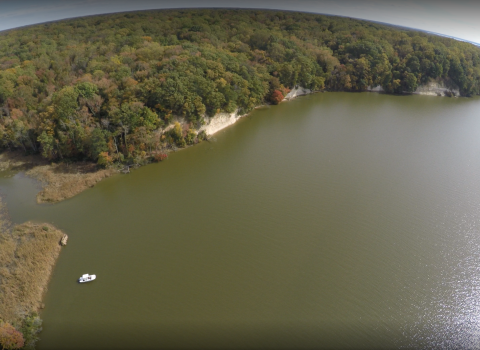I don’t know about you, but names have always been a topic of curiosity for me. Since I was little, I have liked to ask a lot of questions like “Why is grass named grass?” and “Why is the sky called blue?”
Even today, I wonder how places got their names.
Many places are named to commemorate a person or another place. When I was living in northern Virginia, it seemed like the majority of landmarks were named after colonists or towns in England. Many places, however, derive their names from the first peoples of this land. From roads to towns, and from mountains to rivers, Indigenous place names mark the modern landscape.
In fact, nearly thirty national wildlife refuges in the northeast have names with Indigenous origins.
The majority of these refuge names are derived from the Eastern Algonquian language. Some 350 years ago, Algonquian dialects were the common tongue for many native peoples east of the Mississippi River. In this region of the U.S., numerous refuges retain the Native names for landscape features, and a few are named after Tribes or historical Tribal leaders.
Mashpee National Wildlife Refuge, for example, is within the traditional homeland of the Mashpee Wampanoag Tribe, who live close in coastal Massachusetts today. The Tribe is currently active in independently preserving their homelands and in cooperation with the U.S. Fish and Wildlife Service. Refuge staff assists the Tribe with prescribed fire burning, a technique that was practiced by the Mashpee people for thousands of years before the invention of fire trucks and modern technology.
Two refuges in Virginia bear the names of Tribes who reside in the state. The Nansemond Indian Tribe and Rappahannock Tribe were among the six tribes who were granted federal recognition in January 2018. In April 2022, 465 acres of Fones Cliffs, adjacent to Rappahannock River Valley National Wildlife Refuge, was transferred to the Rappahannock Tribe — reconnecting the Tribe with the ancestral home after centuries of separation.
Erie is another example of an Indigenous name that has been given to a refuge. The Erie were an Iroquoian Tribe that resided in western New York until the mid-seventeenth century. Their territory also included northern Ohio and northwestern Pennsylvania.
And Erie isn’t the only refuge named after an Indigenous group in the state of New York. Iroquois National Wildlife Refuge sits on the traditional homelands of the Iroquois, a confederacy of Tribes that included the Cayuga, Cherokee, Huron, Mohawk, Oneida, Onondaga, Seneca, and Tuscarora. The Iroquois territory contained several of the Great Lakes: Ontario, Huron, and Erie, as well as land in New York, Pennsylvania, and southern Ontario and Quebec. Several of these Tribes formed a Confederacy called the Six Nations, Haudenosaunee, or Iroquois Confederacy. Today, these Tribes retain their sovereignty and continue management over their lands held in federal trust.
Another instance of refuges bearing the name of a Native cultural group is the Lenape National Wildlife Refuge Complex. The Lenape were a group of several Eastern Algonquian Tribes who shared the same language and culture, and lived in eastern Pennsylvania, southern New York, and northern New Jersey. Several Tribes trace their ancestry to the Lenni-Lenape geographical area today.
Two Refuges in the region are named after Native American historical figures, Massasoit and Ninigret. Massasoit National Wildlife Refuge is named after the Wampanoag chief, or great Sachem, Massasoit. During Massasoit’s lifetime from 1590 to 1661, the Wampanoag inhabited present-day coastal Massachusetts and eastern Rhode Island. Massasoit signed a treaty with the Pilgrims of the Plymouth Colony, ensuring peace and access to European trade goods. Massasoit and his people taught the pilgrims agricultural techniques. Two federally recognized tribes continue practicing their sovereignty in Massachusetts today: the Mashpee Wampanoag Tribe, and the Wampanoag Tribe of Gay Head (Aquinnah).
Ninigret National Wildlife Refuge is named after Ninigret, Sachem of the Niantic and Narragansett Native Americans. Rhode Island continues to be the home for the federally recognized Narragansett Tribe. Their ancestor and leader, Ninigret, was influential in the Pequot War of 1636 and King Philip’s War of 1675–1677. Ninigret formed long-distance relationships with the Mohawk of the Iroquois Nations and the Pocumtuck of the Connecticut River Valley, in an alliance against the Mohegans,whose descendants currently reside in eastern Connecticut.
Not only are these national wildlife refuges beautiful and an oasis for wildlife to thrive, but they are also a proud recognition of the Indigenous heritage of the northeastern U.S. When we say a Native place name, we are remembering its origin and helping to preserve a legacy of language. Names are significant, and so is asking about their derivation. By asking, we learn something and recognize the past. It is as if our ancestors have a way of speaking up again through us. So pass it on. Ask why.
Plan your visit today to one of the many national wildlife refuges with names associated with our Indigenous heritage:
- Amagansett, New York
- Aroostook, Maine
- Assabet River, Massachusetts
- Chincoteague, Virginia
- Erie, New York
- Iroquois, New York
- Lenape Complex, includes…
- Cherry Valley, Pennsylvania
- Great Swamp, New Jersey
- Shawangunk Grasslands, New York
- Wallkill River, New Jersey
- Missisquoi, Vermont
- Monomoy, Massachusetts
- Nantucket, Massachusetts
- Ninigret, Rhode Island
- Silvio O. Conte, Vermont:
- Nulhegan Basin Division
- Wissatinnewag Division
- Occoquan Bay, Virginia
- Patuxent Research Refuge, Maryland
- Rappahannock River Valley, Virginia
- Sachuest Point, Rhode Island
- Seatuck, New York
- Sunkhaze Meadows, Maine
- Supawna Meadows, New Jersey
- Susquehanna, Maryland
- Umbagog, Maine and New Hampshire
- Wapack, New Hampshire











